
Economics_-_New_Ways_of_Thinking
.pdf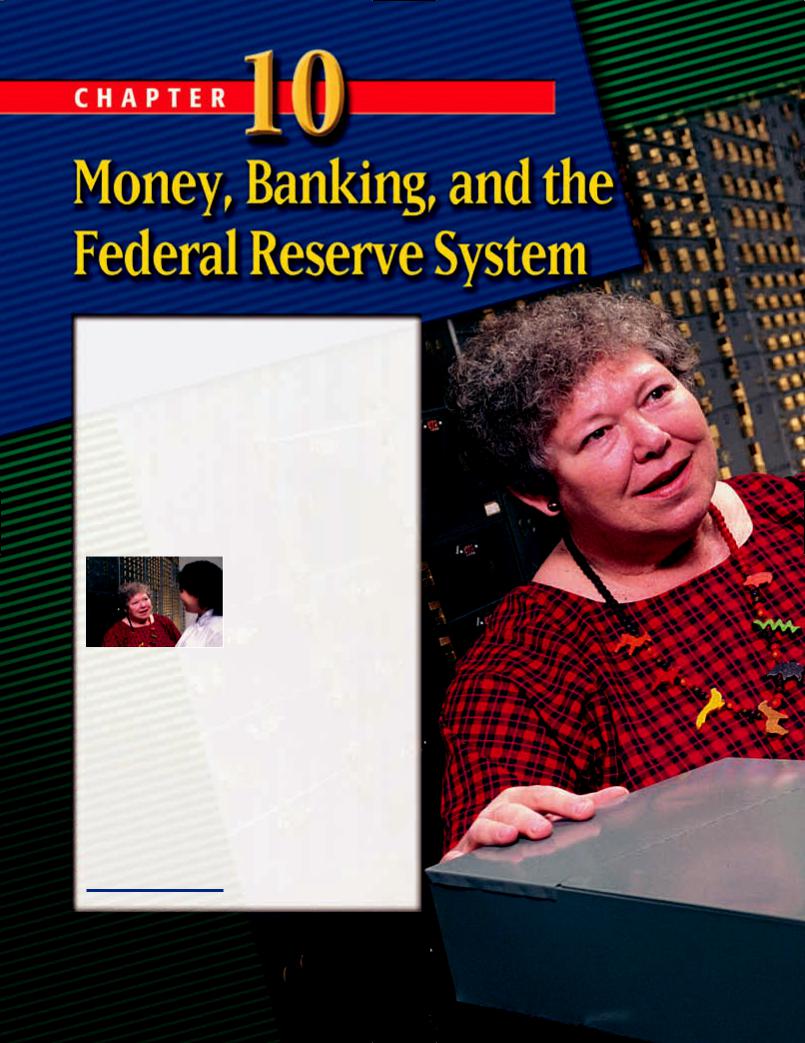
Why It Matters
Suppose that tomorrow morning you woke up, and all the money in the world was gone. It disappeared. How would the
world be different? Would it be a better or a worse place to live? Would people be more greedy, less greedy, or about the same? Would people work harder, or work less?
When someone mentions the word money, you might think of a $20 bill. Money is cold, hard cash to most of us, but money involves much more than that $20 bill. In this chapter you will begin to find out about the story of money.
You will learn how money came into existence and the purposes it serves today. You will also learn about banking and the Federal Reserve System, which work together to change the amount of money in circulation at any given time. As you complete the chapter, you will begin to see how the changing money supply can affect your life in the years to come.
254

The following events occurred one day in February.
8:15 A.M. The members of the Federal Open Market Committee (FOMC), in Washington, D.C., will start their meeting at 9 a.m. The members of the FOMC have a lot to say on whether
the money supply of the United States increases, decreases, or remains constant. Many people would like to hear what goes on at these meetings. If you knew what was discussed, you might
be able to profit from it. So now, at this time, the room in which the meeting will take place is being swept for electronic bugs.
• What specifically does the FOMC do that is so important?
9:00 A.M. Mrs. Harris teaches English literature at Monroe High School and is talking about the book The Strange Case of Dr. Jekyll and Mr. Hyde. She reads from
the book: “It was on the moral side, and in my own person, that I learned to recognize the thorough and primitive duality of man: I saw that, of the two natures that contended in the field of my consciousness, even if I could rightly be said to be either, it was only because
Iwas radically both. . . .”
•What does Robert Louis Stevenson’s The Strange Case of Dr. Jekyll and Mr. Hyde have to do with the material in an economics text?
3:44 P.M. Carl listens to the news on his car radio. The newscaster states, “Today, the Fed announced that it would raise the discount rate by one-quarter of one percentage point or 25 basis points. This decision shows that the Fed is probably worried about the recent rapid rate of increase in the money supply.”
• What is the discount rate and how is it related to changes in the money supply?
5:29 P.M. At NBC Studios in Burbank, California, Jay Leno, host of the Tonight Show with Jay Leno, is getting ready to go on. He tapes his show every weekday at this time. The announcer of the Tonight Show is warming up his voice. Jay goes over in his mind his first two jokes. Although he will read all of his jokes off large white posters held up in front of him, he still likes to go over in his mind his first few words.
• What does Jay Leno have to do with material in an economics text?
255
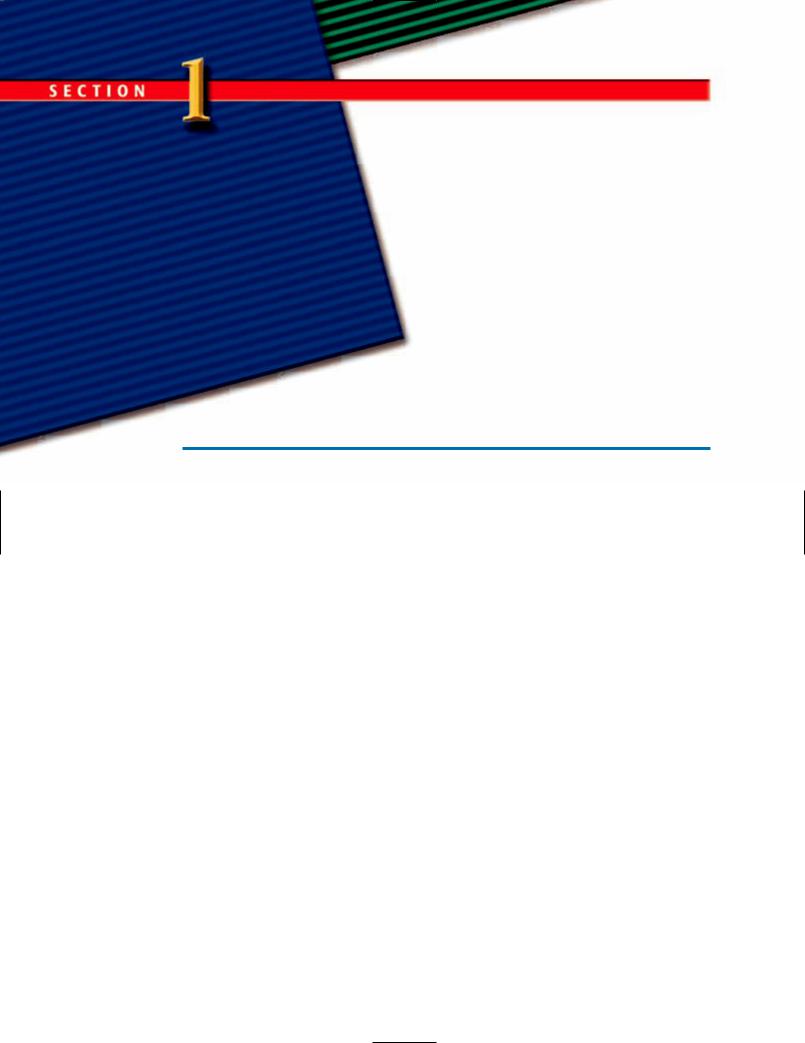
The Origins of
Money
Focus Questions
What is a barter economy?
How did money emerge out of a barter economy?
What is money?
What gives money its value?
What are the functions of money?
Key Terms
barter economy transaction costs money
medium of exchange unit of account
store of value
fractional reserve banking
barter economy
An economy in which trades are made in goods and services instead of in money.
transaction costs
The costs associated with the time and effort needed to search out, negotiate, and consummate an exchange.
What’s It Like Living in a
Barter Economy?
A barter economy is an economy with no money. The only way you can get what you want in a barter economy is to trade something you have for it. Suppose you have apples and want oranges. You trade two apples for three oranges.
Life in a barter economy can be difficult. It can take a lot of time and effort to get what you want. Suppose you produce utensils such as forks, spoons, and knives. No one can live on utensils alone, so you set out to trade your utensils for bread, meat, and other necessities. You come across a person who bakes bread and ask if he is willing to trade some bread for some utensils. He says, “Thank you very much, but no. I have all the utensils I need.” You ask him what he would like instead of utensils. He says he would like to have some fruit, and that if you had fruit he would be happy to trade bread for fruit.
You go on your way and find another person with bread. You ask her if she wants to
trade bread for utensils. Like the first person, she says no, but she would be happy to trade bread for meat if you had any. You do not, so you move on to find another person who, you hope, will be willing to trade bread for utensils.
What is the problem here? You encounter people who have what you want but (unfortunately for you) don’t want what you have. (You find the person who has the bread that you want, but this person doesn’t want the utensils that you have.) What makes living in a barter economy difficult is that many of the people you want to trade with don’t want to trade with you.
In this type of situation, trade is time consuming. It could take all day, if not longer, to find a person who wants to trade bread for utensils. Economists state the problem this way: the transaction costs of making exchanges are high in a barter economy. Think of the transaction costs as the time and effort you have to spend before you can make an exchange. If the transaction costs could somehow be lower, trading would be easier.
256 Chapter 10 Money, Banking, and the Federal Reserve System
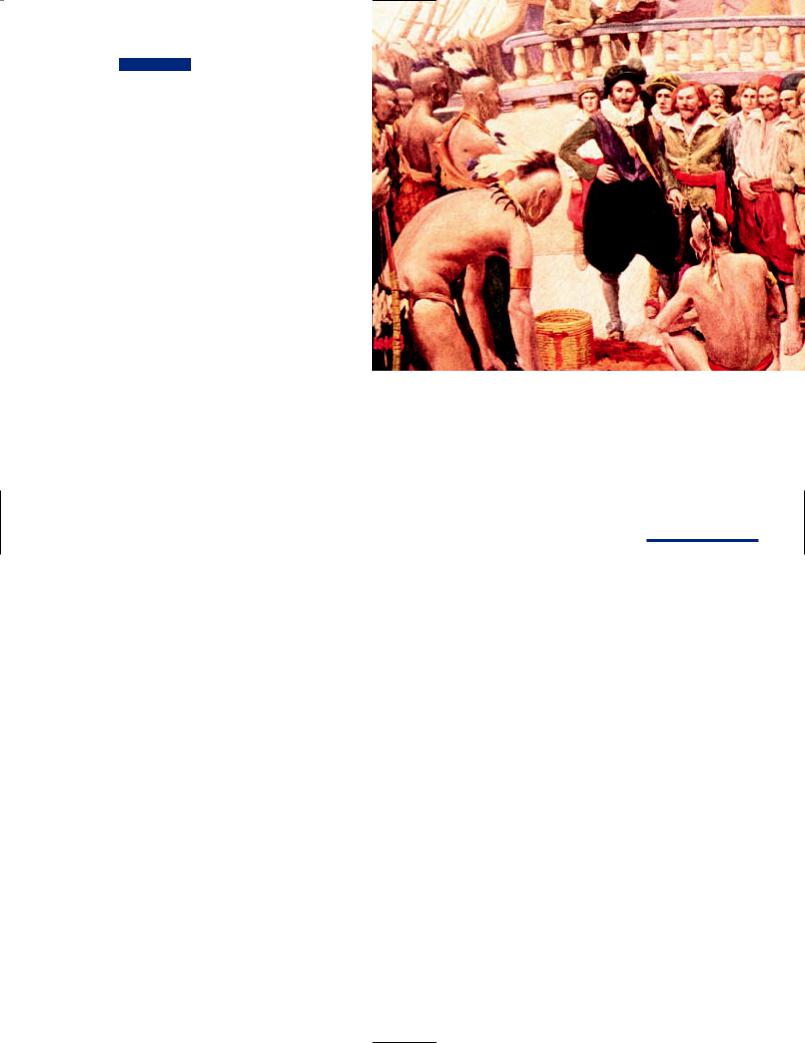
Taylor wants to buy a house and a gallon of milk. He has to do more to buy a house than he has to do to buy a gallon of milk. To buy a house, he has to find the house, inspect the house, bargain on the price of the house, take out a loan to buy the house, and much more. To buy a gallon of milk, he simply walks into a grocery store, pays at the counter, and walks out. The transaction costs of buying a house are greater than the transaction costs of buying a gallon of milk.
How and Why Did Money Come to Exist?
How can an individual living in a barter economy reduce the transaction costs of making exchanges? In a barter economy with, say, 100 goods, some goods are more readily accepted in exchange than others. For example, good A might be accepted (on average) every tenth time it is offered in exchange, while good B might be accepted every seventh time. If you are going out today to trade in a barter economy, which good, A or B, would you prefer to have in your possession? The answer is B, because it is more likely to be accepted in a trade than A. In other words, to reduce the transaction costs of making exchanges, it is better to offer B than A.
Before you can offer B, though, you have to have it. So suppose someone offers to trade good B for your utensils. You don’t really want to consume good B (in the same way that you want to consume bread), but you realize that good B will be useful in making exchanges. You accept the trade because later you will use good B to lower the transaction costs of getting what you want.
Once some people begin accepting a good because it reduces the transaction costs of exchange, others will follow. After you accepted good B, it had greater acceptability than it used to have. Because you accepted it, even though it wasn’t the good you really wanted, perhaps it will be accepted every sixth time now instead of every seventh time. This greater acceptability makes good B more useful to other people than it was previously.
Then, when Pheng accepts good B, it is even more likely that someone else will accept good B. Can you see what is happening? That you accepted good B made it more likely that Pheng would accept it. That Pheng accepted it made it more likely that someone else would accept it. Eventually, everyone will accept good B in exchange. When this time arrives—when good B is widely accepted in exchange—good B is called money. Money is any good that is widely accepted in exchange and in the repayment of debts. Historically, goods that evolved into money included gold, silver, copper, rocks, cattle, and shells, to name only a few.
 You are on an island with 10 other people without money. You start to make trades with the others on the island— some shells for some mango, two small bluish fish for one large reddish fish, some rocks for some seaweed. One day you learn that of all things on the island, a coconut is more widely accepted in exchange than anything else. In other words, if you have a coconut to trade, six out of every 10 people will trade with you, but for other items (shells, fish, rocks) only four, or fewer, out of every 10 people will trade with you. You realize that those coconuts can make it a whole lot easier to trade: “I had better always accept a coconut (in a trade) when someone offers one to me because I can then turn around and use the coconut to get what I
You are on an island with 10 other people without money. You start to make trades with the others on the island— some shells for some mango, two small bluish fish for one large reddish fish, some rocks for some seaweed. One day you learn that of all things on the island, a coconut is more widely accepted in exchange than anything else. In other words, if you have a coconut to trade, six out of every 10 people will trade with you, but for other items (shells, fish, rocks) only four, or fewer, out of every 10 people will trade with you. You realize that those coconuts can make it a whole lot easier to trade: “I had better always accept a coconut (in a trade) when someone offers one to me because I can then turn around and use the coconut to get what I
These Native Americans are trading furs with explorer Henry Hudson.
What were some disadvantages of living in a barter economy?
money
A good that is widely accepted for purposes of exchange and in the repayment of debt.
Section 1 The Origins of Money 257
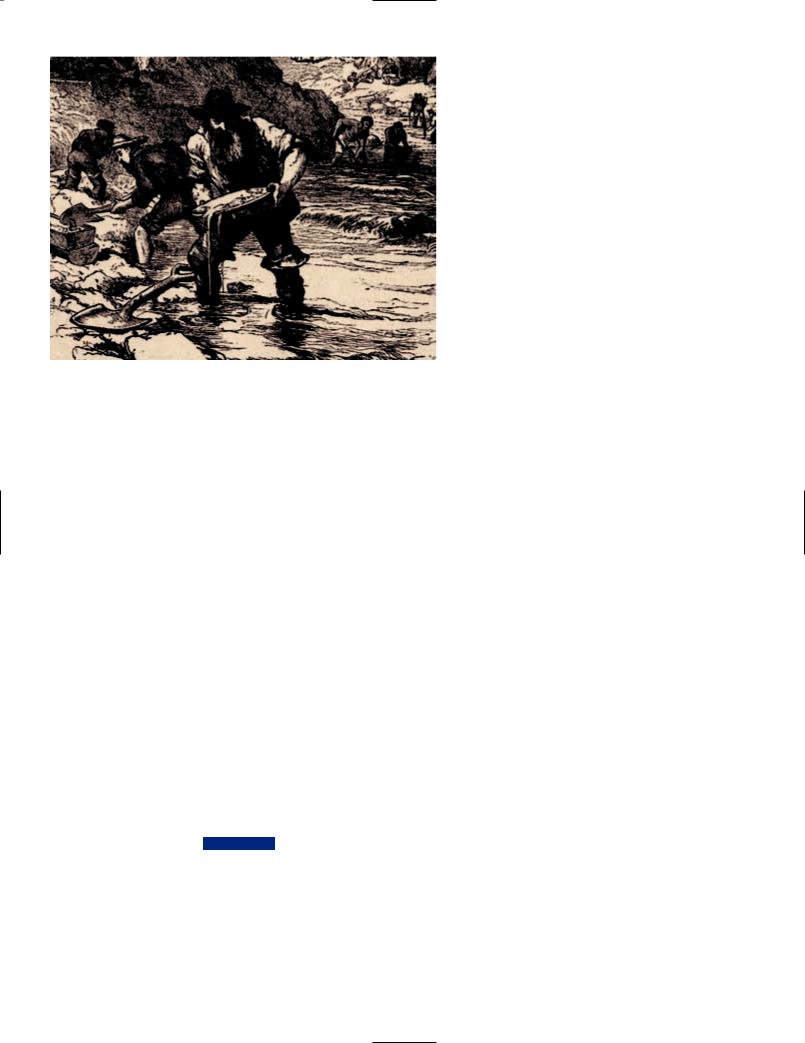
This woodcut |
want from others.” So you start accepting |
shows men panning |
coconuts in trade, even though you don’t |
for gold in California |
like coconuts, and because you do, the |
in the 1850s. What |
acceptability of coconuts is now even greater |
materials, other |
than before. Then someone else sees that the |
than gold, have |
acceptability of coconuts is on the rise, and |
people used for |
so she begins accepting coconuts in all |
money? |
trades. On it goes until almost everyone real- |
|
izes that it is in their best interests to accept |
|
|
|
coconuts. Coconuts are now money. |
What Gives Money Value?
Forget coconuts. Let’s turn to a $10 bill. Is a $10 bill money? The $10 bill is widely accepted for purposes of exchange, of course, and therefore it is money.
What gives money (say, the $10 bill) its value? Like good B and the coconuts in the earlier examples of a barter economy, our money (today) has value because of its general acceptability. Money has value to you because you know that you can use it to get what you want. You can use it to get what you want, however, only because other people will accept it in exchange for what they have.
E X A M P L E : Imagine a time in the future. Ryan begins to walk to a local shopping center. On the way, he stops by the convenience store to buy a doughnut and milk. He tries to pay for the food with two $1 bills. The owner of the store says that he no longer accepts dollar bills in exchange for
what he has to sell. This story repeats itself all day with different store owners; no one is willing to accept dollar bills for what he or she has to sell. Suddenly, dollar bills have little or no value to Ryan. If he cannot use them to get what he wants, they are simply paper and ink, with no value at all.
 Between 1861 and 1865, during the Civil War, in the South Confederate notes (Confederate money) had value because Confederate money was accepted by people in the South for purposes of exchange. Today in the South, Confederate money has little value (except for historical collections), because it is not widely accepted for purposes of exchange. You cannot pay for your gasoline at a service station in Alabama with Confederate notes.
Between 1861 and 1865, during the Civil War, in the South Confederate notes (Confederate money) had value because Confederate money was accepted by people in the South for purposes of exchange. Today in the South, Confederate money has little value (except for historical collections), because it is not widely accepted for purposes of exchange. You cannot pay for your gasoline at a service station in Alabama with Confederate notes.
Are You Better Off Living in
a Money Economy?
The transaction costs of exchange are lower in a money economy than in a barter economy. In a barter economy, not everyone you want to trade with wants to trade with you. In a money economy, however, everyone you want to buy something from wants what you have—money. In short, a willing trading partner lowers the transaction costs of making exchanges.
Lower transaction costs translate into less time needed for you to trade in a money economy than in a barter economy. Using money, then, frees up some time for you. With that extra time, you can produce more of whatever it is you produce (accounting services, furniture, computers, or novels), consume more leisure, or both. In a money economy, then, people produce more goods and services and consume more leisure than they would in a barter economy. The residents of money economies are richer in goods, services, and leisure than the residents of barter economies.
The residents of money economies are more specialized, too. If you lived in a barter economy, it would be difficult and time consuming to make everyday transactions. You probably would produce many things yourself rather than deal with the hardship of
258 Chapter 10 Money, Banking, and the Federal Reserve System
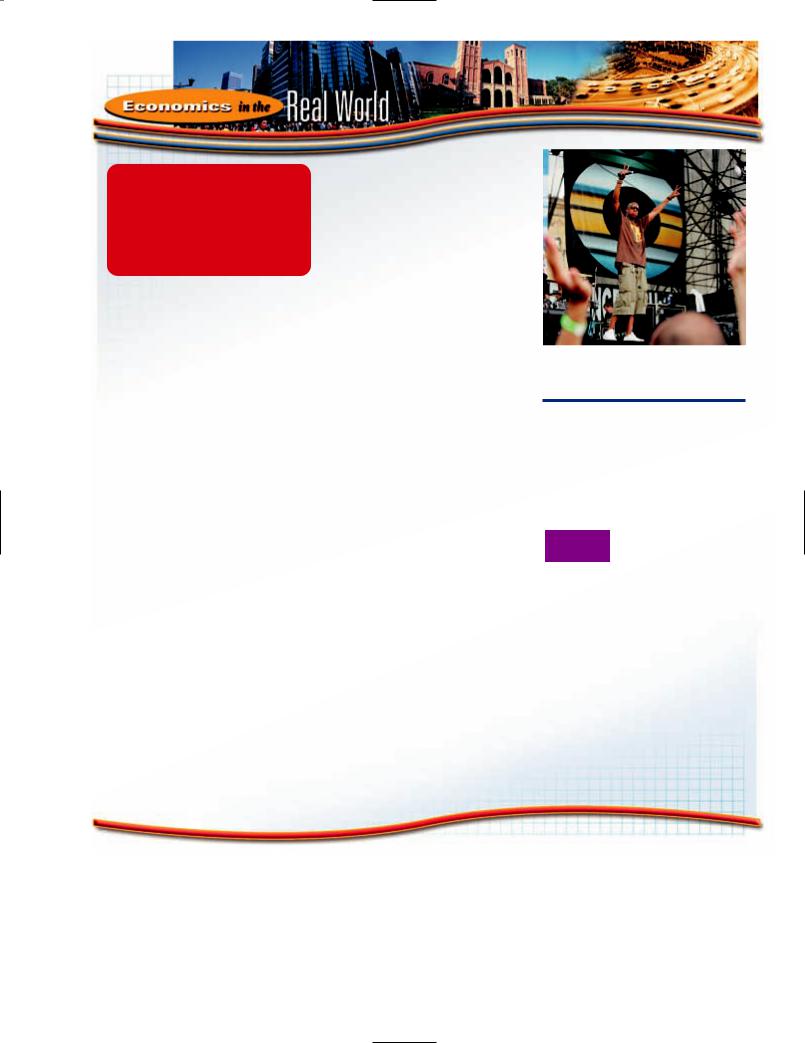
Would You Hear Hip-Hop in a Barter Economy?
??????????????????
Suppose one of today’s hiphop artists lived in a barter economy. Would he still be a hip-
hop artist?
Before we answer this question, let’s look at what an average day, living in a money economy, looks like for a hip-hop artist. He has to work on writing songs, rehearsing songs, planning for a tour, working on a video. So much of his day is wrapped up in his highly specialized work of being a hip-hop artist.
Would he be engaged in the same activities if he lived in a barter economy? Probably not. A typical day might go like this. He wakes up, eats breakfast, and then sees if he can trade a little of his hip-hop for some goods. He meets a woman with bread and asks if she is willing to trade some bread for a little hiphop. The person tells the hip-hop artist that she is not interested in making a trade. She says she doesn’t care much for hip-hop.
Onward the hip-hop artist goes, trying to find someone who will trade goods for hip-hop. He might run into a few people, but we can
be sure that by the end of the day the hip-hop artist finds it fairly hard to make simple exchanges: a song for some steak, a song for some fruit, a song for a shirt.
What is likely to happen to the hip-hop artist? He will quickly recognize how difficult making trades is and decide to make a lot of what he needs to survive himself. He might start making his own bread and his own clothes instead of trying to trade hip-hop for each. In short, in a barter economy, because trade is so difficult and time consuming, people are likely to try to produce for themselves the things they need. In the end, the hip-hop artist is so busy making bread, clothes, and so on that he really doesn’t have much time to work on his hip-hop. As a result, hiphop is likely to go by the wayside. Soon, he is no longer a hip-hop artist, but just another person producing many of the things he needs.
The lesson learned? Few people would specialize in a barter economy to the degree they do in a money economy. After all, what is the probability that everyone whose goods you want will want the one thing that you produce?
In a money economy, in contrast, everyone is willing to trade what they have for money. The risk in specializing is less than in a barter
Jay-Z on stage. Would Jay-Z be a hiphop artist in a barter economy?
economy, so people produce one thing (hip-hop songs, attorney services, corn, and so on), sell it for money, and then use the money to make their preferred purchases.
Do you think specialization is more likely in
a large city (such as New York City) or a small city (some city with a population under 7,000 persons for example)? Explain your answer. Also, do you think the fact that you can buy goods online makes it more likely or less likely that you will specialize? Explain your answer.
producing only one good and then trying to exchange it for so many other goods. In other words, the higher the transaction costs of trading, the less likely you would want to trade, and the more likely you would pro-
duce the goods that you would otherwise have to trade for.
In a money economy, however, it is neither difficult nor time consuming to make everyday transactions. The transaction costs
Section 1 The Origins of Money 259
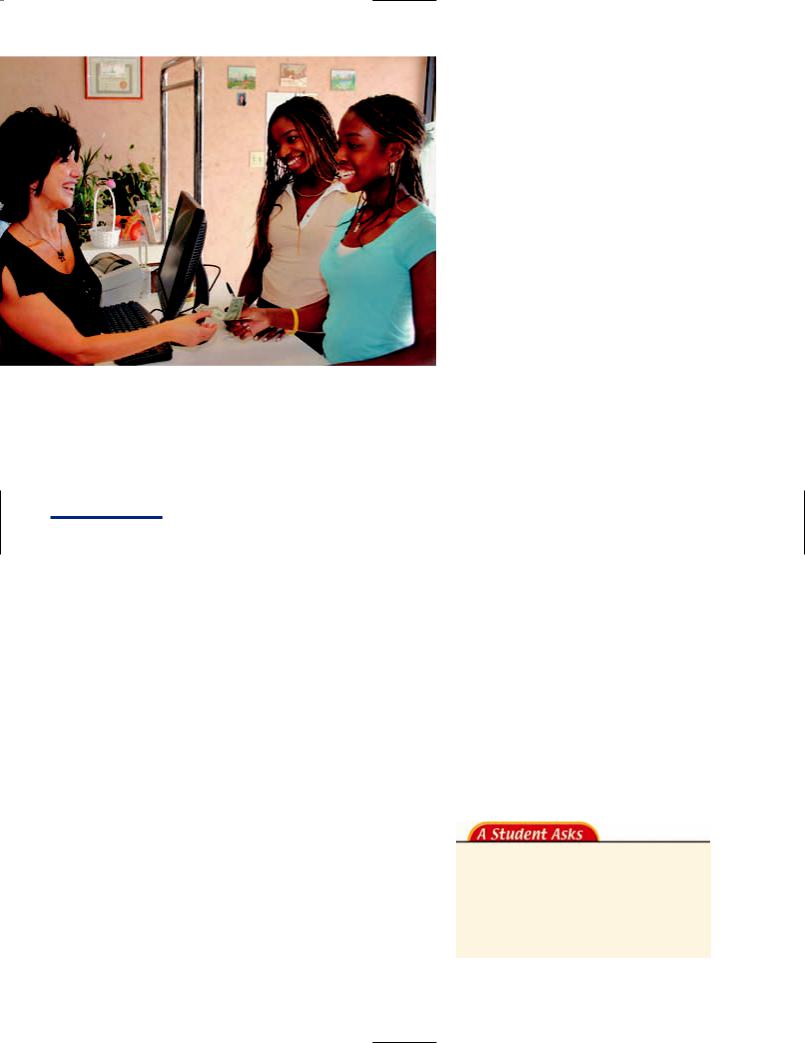
Money lowers the transaction costs of making exchanges.
How much more difficult would this transaction be without money?
medium of exchange
Anything that is generally acceptable in exchange for goods and services.
unit of account
A common measurement used to express values.
store of value
Something with the ability to hold value over time.
of exchange are low compared to what they are in a barter economy. You have the luxury of specializing in the production of one thing (fixing faucets, writing computer programs, teaching students), selling that one thing for money, and then using the money to buy whatever good or service you want to buy.
In only very few places in the world today is barter still practiced. In those places, you will find that the people have a low standard of material living, and they are not nearly as specialized as they are in money economies.
What Are the Three
Functions of Money?
Money has three major functions: a medium of exchange, a unit of account, and a store of value.
Money as a Medium of Exchange
A medium of exchange is anything that is generally acceptable in exchange for goods and services. As we have seen, then, the most basic function of money is as a medium of exchange. Money is part of (present in) almost every exchange made.
Money as a Unit of Account
A unit of account is a common measurement used to express values. Money func-
tions as a unit of account, which means that all goods can be expressed in terms of money. For example, we express the value of a house in terms of dollars (say, $280,000), the value of a car in terms of dollars (say, $20,000), and the value of a computer in terms of dollars (say, $2,000).
Money as a Store of Value
A good is a store of value if it maintains its value over time. Money serves as a store of value. For example, you can sell your labor services today, collect money in payment, and wait for a future date to spend the money on goods and services. You do not have to rush to buy goods and services with the money today; it will store value to be used at a future date.
To say that money is a store of value does not mean that it is necessarily a constant store of value. Let’s say that the only good in the world is apples, and the price of an apple is $1. Julio earns $100 on January 1, 2006. If he spends the $100 on January 1, 2006, he can buy 100 apples. Suppose he decides to hold the money for one year, until January 1, 2007. Suppose also that the price of apples doubles during this time to $2. On January 1, 2007, Julio can buy only 50 apples. What happened? The money lost some of its value between 2006 and 2007. If prices rise, the value of money declines.
When economists say that money serves as a store of value, they do not mean to imply that money is a constant store of value, or that it always serves as a store of value equally well. Money is better at storing value at some times than at other times. (Money is “bad” at storing value when prices are rapidly rising.)
For a summarized comparison of the three major functions of money, see Exhibit 10-1.
QUESTION: Can money lose its value very fast over a short period of time?
ANSWER: Money will lose its value fairly quickly (and therefore not be a good store of value) any time prices rise quickly over
260 Chapter 10 Money, Banking, and the Federal Reserve System
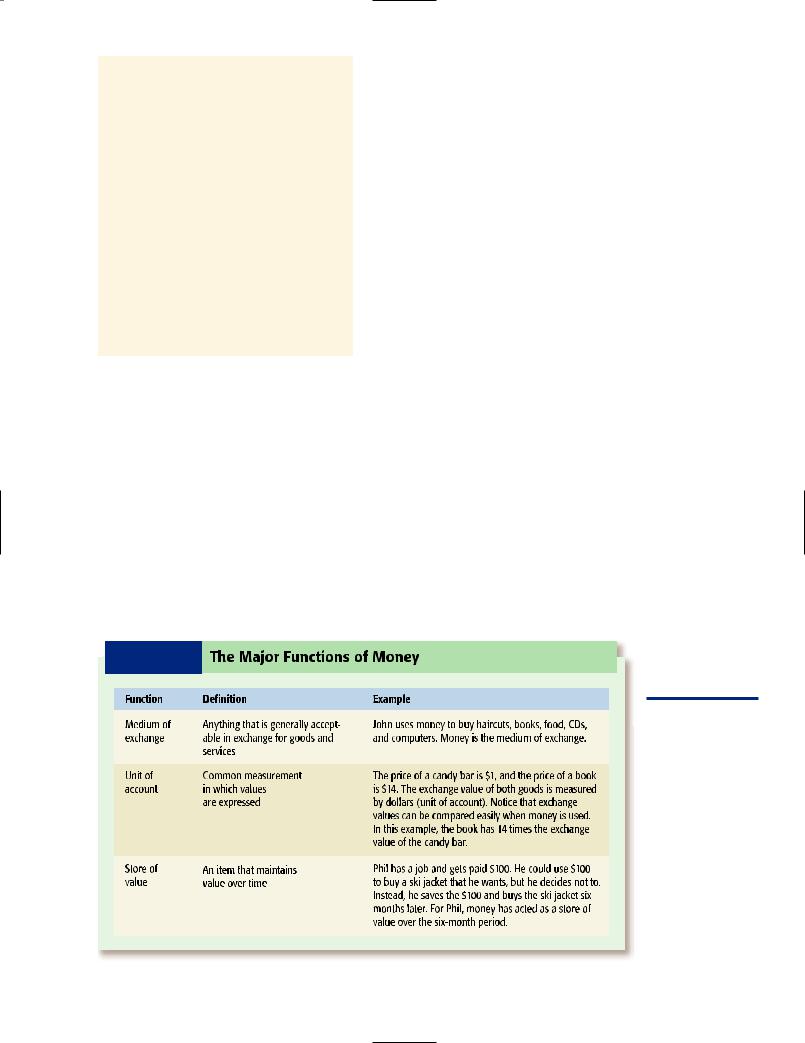
a short period of time. A classic example is Germany in 1923 when prices were rising so quickly, and money was losing its value so fast, that workers in Germany were being paid (with money) three times a day. They might be paid in the morning, use the money right away to buy goods, then be paid in the afternoon, use that money right away to buy goods, and so on. In other words, if they waited too long to use the money they were paid, prices would have risen by so much that the amount of money they had wouldn’t buy much. So they ended up spending their money almost as quickly as they received it.
Who Were the Early
Bankers?
Our money today is easy to carry and transport, but it was not always that way. For example, when money was principally gold coins, carrying it was neither easy nor safe. Gold is heavy, and transporting thousands of gold coins is an activity that could easily draw the attention of thieves. Thus, individuals wanted to store their gold in a safe place. The person most individuals turned to was the goldsmith, someone
already equipped with safe storage facilities. Goldsmiths were the first bankers. They took in other people’s gold and stored it for them.
To acknowledge that they held deposited gold, goldsmiths issued receipts called warehouse receipts to their customers. For example, Adam might have a receipt from the goldsmith Turner stating that he deposited 400 gold pieces with Turner. Before long, people began to circulate the warehouse receipts in place of the gold itself (gold was not only inconvenient for customers to carry, but also inconvenient for merchants to accept). For instance, if Adam wanted to buy something for 400 gold pieces, he might give a warehouse receipt to the seller instead of going to the goldsmith, obtaining the gold, and then delivering it to the seller. Using the receipts was easier than dealing with the gold itself for both parties. In short, the warehouse receipts circulated as money— that is, they became widely acceptable for purposes of exchange.
Goldsmiths began to notice that on an average day, few people came to redeem their receipts for gold. Most individuals were simply trading the receipts for goods. At this stage, warehouse receipts were fully backed by gold. The receipts simply represented, or stood in place of, the actual gold in storage.
E X H I B I T 10-1 The Major Functions of Money
Function |
Definition |
Example |
Medium of
exchange
Unit of account
Store of value
Anything that is generally acceptable in exchange for goods and services
Common measurement in which values
are expressed
An item that maintains value over time
John uses money to buy haircuts, books, food, CDs, and computers. Money is the medium of exchange.
The price of a candy bar is $1, and the price of a book is $14. The exchange value of both goods is measured by dollars (unit of account). Notice that exchange values can be compared easily when money is used. In this example, the book has 14 times the exchange value of the candy bar.
Phil has a job and gets paid $100. He could use $100 to buy a ski jacket that he wants, but he decides not to. Instead, he saves the $100 and buys the ski jacket six months later. For Phil, money has acted as a store of value over the six-month period.
This table summarizes the major functions of money.
Section 1 The Origins of Money 261
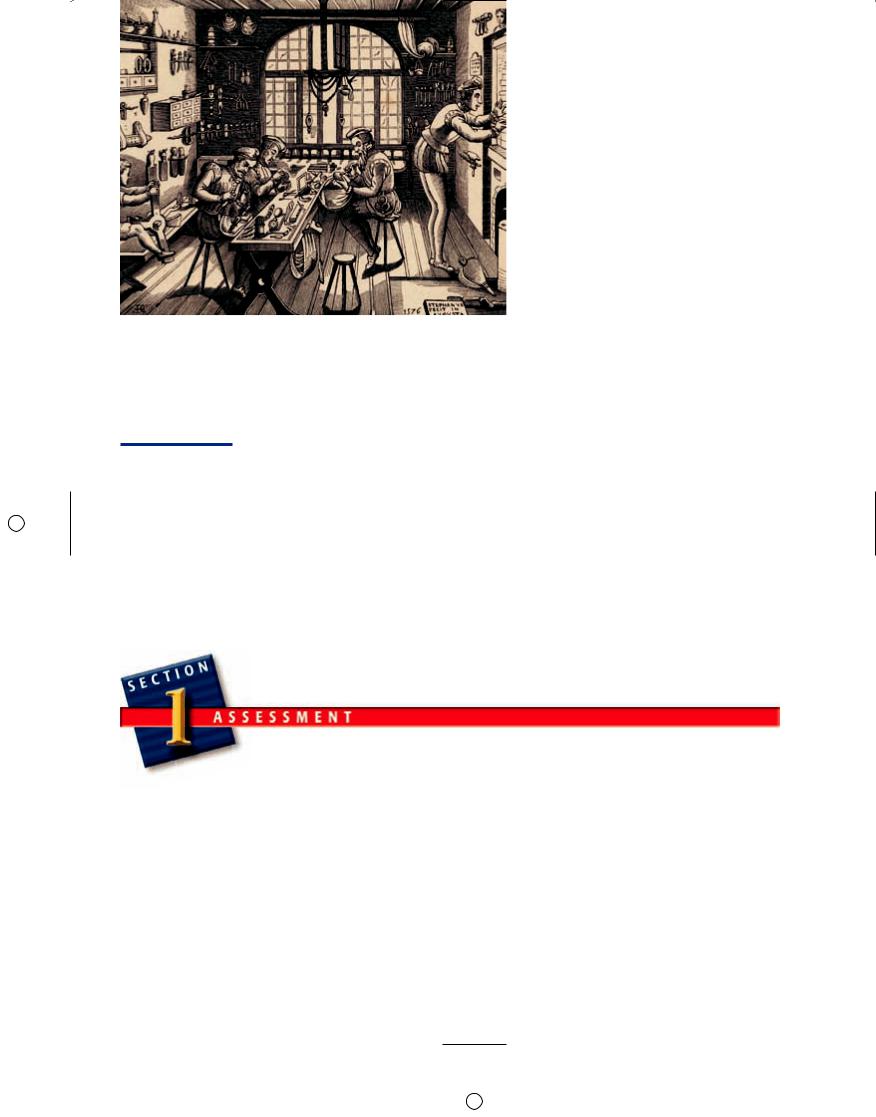
A goldsmith’s shop of the sixteenth century. Why were goldsmiths among the first to become bankers?
fractional reserve banking
A banking arrangement in which banks hold only a fraction of their deposits and lend out the remainder.
Some goldsmiths, however, began to think, “Suppose I lend out some of the gold that people have deposited with me. If I lend it to others, I can charge interest for the loan. And since receipts are circulating in place of the gold, I will probably never be faced with redeeming everyone’s receipts for gold at once.” Some goldsmiths did lend out some of the gold deposited with them and collected the interest on the loans. The consequence of this lending activity was an increase in the supply of money, measured in terms of gold and paper receipts. Remember, both gold and paper warehouse receipts were widely accepted for purposes of exchange.
A numerical example can show how the goldsmiths’ activities increased the supply of money. Suppose the world’s entire money
coins with the goldsmith. To keep things simple, suppose the goldsmith gives out 1 paper receipt for each gold coin deposited. In other words, if Flores deposits 3 coins with a goldsmith, she receives 3 warehouse receipts, each representing a coin.
The warehouse receipts begin to circulate instead of the gold itself, so the money supply consists of 100 paper receipts, whereas before it consisted of 100 gold coins. Still, the number is 100. So far, so good.
Now the goldsmith decides to lend out some of the gold and earn interest on the loans. Suppose Robert wants to take out a loan for 15 gold coins. The goldsmith grants the loan. Instead of handing over 15 gold coins, though, the goldsmith gives Robert 15 paper receipts.
What happens to the money supply? Before the goldsmith went into the lending business, the money supply consisted of 100 paper receipts. Now, though, the money supply has increased to 115 paper receipts. The increase in the money supply (as measured by the number of paper receipts) is a result of the lending activity of the goldsmith.
The process described here was the beginning of fractional reserve banking. We live under a fractional reserve banking system today. Under a fractional reserve banking system, such as the one that currently operates in the United States, banks (like the goldsmiths of years past) create money by holding on
Defining Terms |
Reviewing Facts and |
Critical Thinking |
||
1. Define: |
Concepts |
5. Is specialization in a |
||
a. |
barter economy |
2. |
What gives money its |
money economy more or |
b. |
transaction costs |
|
value? |
less likely to happen than |
c. |
money |
3. |
Money serves as a unit of |
in a barter economy? |
d. |
medium of exchange |
|
account. Give an example |
|
e. |
unit of account |
|
to illustrate what this |
|
f. |
store of value |
|
means. |
|
g. |
fractional reserve |
4. |
What does it mean to say |
|
|
banking |
|
that the United States has |
|
|
|
|
a fractional reserve bank- |
|
|
|
|
ing system? |
|
262 Chapter 10 Money, Banking, and the Federal Reserve System
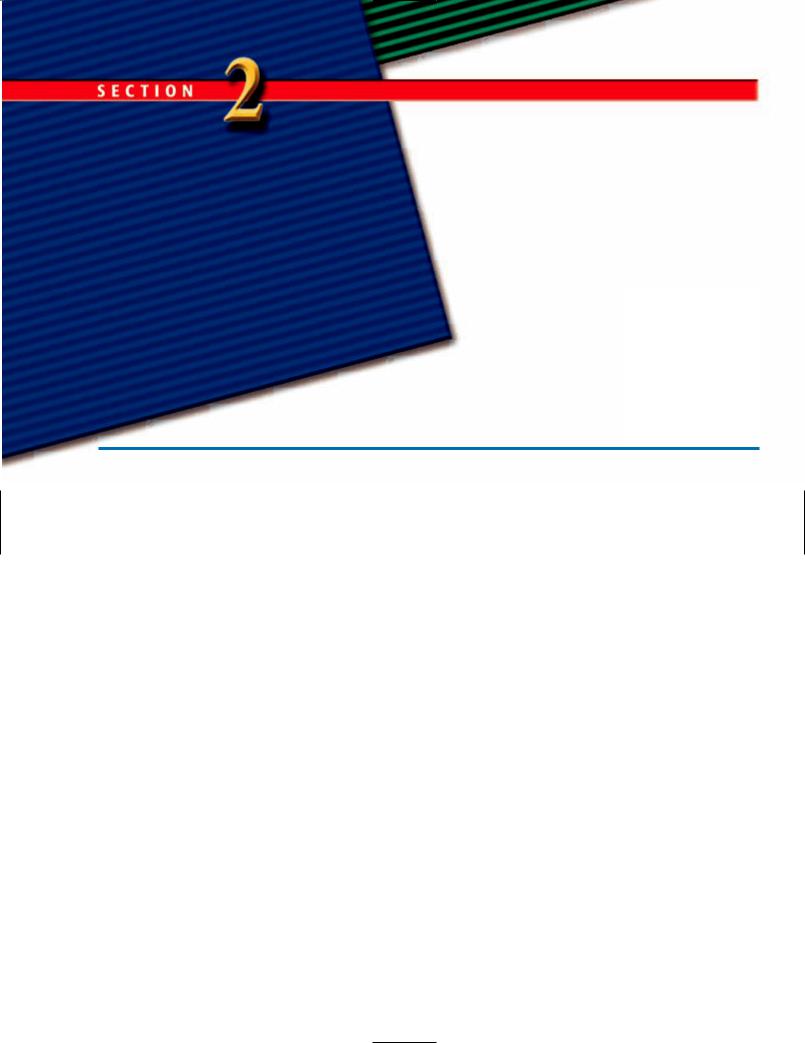
The Money
Supply
Focus Questions
What does the money supply consist of?
What is a Federal Reserve note?
What is and what is not “money”?
What causes interest rates to change?
Key Terms
money supply currency
Federal Reserve note demand deposit savings account near-money
loanable funds market
What Are the Components
of the Money Supply?
The most basic money supply—some- times referred to as M1 (M-one)—consists of three components we will soon identify. Other “money supplies” besides M1 include a broader measure of the money supply called M2 (M-two). For purposes of simplicity, when we discuss the money supply in this text, we are referring to M1. The M1 in the United States is composed of (1) currency, (2) checking accounts, and (3) traveler’s checks.
1.Currency. Currency includes both coins (such as quarters and dimes) minted by the U.S. Treasury and paper money. The paper money in circulation consists of
Federal Reserve notes. If you look at a dollar bill, you will see at the top the words “Federal Reserve Note.” The Federal Reserve System, which is the central bank of the United States (discussed in a later section), issues Federal Reserve notes.
2.Checking accounts. Checking accounts are accounts in which funds are deposited and can be withdrawn simply by writing a check. Sometimes checking accounts are referred to as demand deposits, because the funds can be converted to currency on demand and given to the person to whom the check is made payable. For example, suppose Malcolm has a checking account at a local bank with a balance of $400. He can withdraw up to $400 currency from his account, or he can transfer any dollar amount up to $400 to someone else by simply writing a check to that person.
3.Traveler’s checks. A traveler’s check is a check issued by a bank in any of several denominations ($10, $20, $50, and so on) and sold to a traveler (or to anyone who wishes to buy it), who signs it at the time it is issued by the bank and then again in the presence of the person cashing it.
In August 2005, $710 billion in currency was in circulation, along with $619 billion in
money supply
The total supply of money in circulation, composed of currency, checking accounts, and traveler's checks.
currency
Coins issued by the U.S. Treasury and paper money (called Federal Reserve notes) issued by the Federal Reserve System.
Federal Reserve note
Paper money issued by the Federal Reserve System.
demand deposit
An account from which deposited funds can be withdrawn in currency or transferred by a check to a third party at the initiative of the owner.
Section 2 The Money Supply 263
